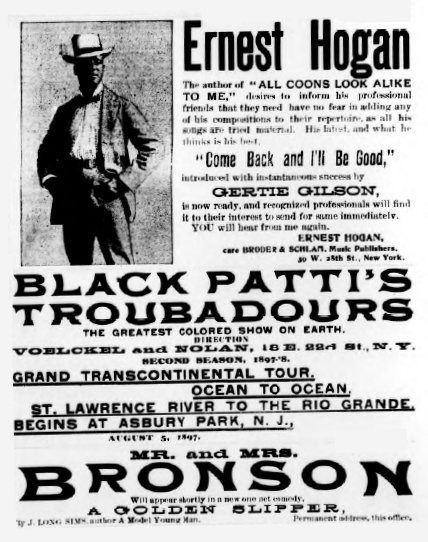From the mid-1870s, as white blackface minstrelsy became increasingly lavish and moved away from "Negro subjects", black troupes took the opposite tack.
[63] The popularity of the
Fisk Jubilee Singers and other
jubilee singers had demonstrated northern white interest in white religious music as sung by blacks, especially
spirituals. Some jubilee troupes pitched themselves as quasi-minstrels and even incorporated minstrel songs; meanwhile, blackface troupes began to adopt first jubilee material and then a broader range of southern black religious material. Within a few years, the word "jubilee", originally used by the Fisk Jubilee Singers to set themselves apart from blackface minstrels and to emphasize the religious character of their music, became little more than a synonym for "plantation" material.
[64] Where the jubilee singers tried to "clean up" Southern black religion for white consumption, blackface performers exaggerated its more exotic aspects.
[65]
African-American blackface productions also contained buffoonery and comedy, by way of self-parody. In the early days of African-American involvement in theatrical performance, blacks could not perform without blackface makeup, regardless of how dark-skinned they were. The 1860s "colored" troupes violated this convention for a time: the comedy-oriented endmen "corked up", but the other performers "astonished" commentators by the diversity of their hues.
[66] Still, their performances were largely in accord with established blackface stereotypes.
[67]
These black performers became stars within the broad African-American community, but were largely ignored or condemned by the black bourgeoisie.
James Monroe Trotter —
a middle-class African American who had contempt for their "disgusting caricaturing" but admired their "highly musical culture"—wrote in 1882 that "few... who condemned black minstrels for giving 'aid and comfort to the enemy'" had ever seen them perform.
[68] Unlike white audiences, black audiences presumably always recognized blackface performance as caricature, and took pleasure in seeing their own culture observed and reflected, much as they would half a century later in the performances of
Moms Mabley.
[69]
















